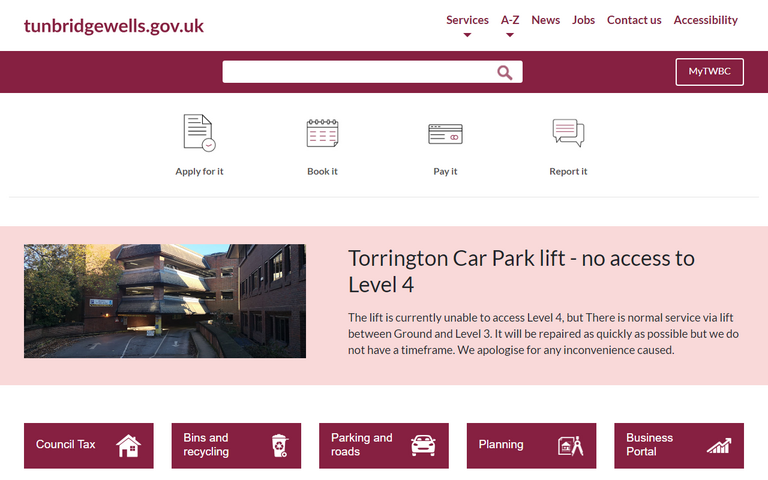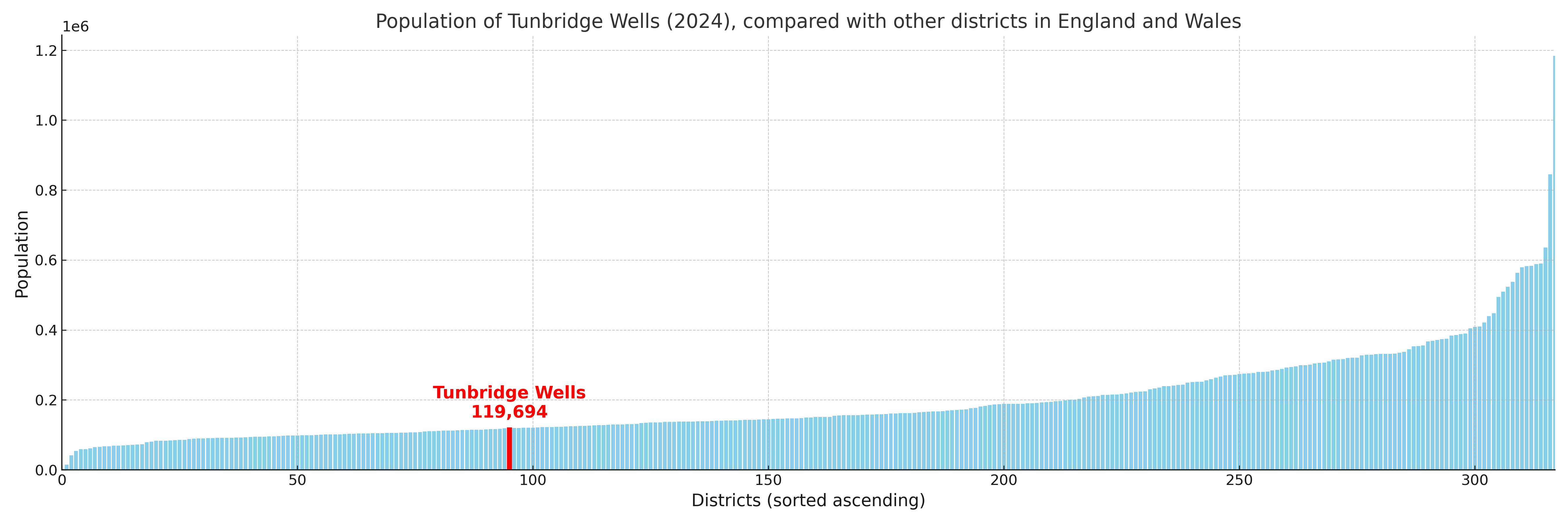Tunbridge Wells
§ This page gives an overview of the Tunbridge Wells local authority district, bringing together key facts, maps, and data to help you quickly understand the area. One of 361 district profiles on Baseview.
Overview ⁞ Tunbridge Wells, in west Kent, is a historic spa town surrounded by countryside and the High Weald Area of Outstanding Natural Beauty. Royal Tunbridge Wells itself is famed for the Pantiles, a Georgian colonnaded promenade, and parks such as Dunorlan and Calverley Grounds. The district includes villages such as Cranbrook and Goudhurst, with timber-framed houses and historic churches, alongside orchards, hop gardens, and wooded hills. The High Rocks sandstone outcrops and scenic valleys define the geography, making it a blend of heritage and natural beauty.
Tunbridge Wells Boundary Map
This map shows the official boundary of the Tunbridge Wells local authority district, based on the latest geographic data published by the Office for National Statistics (ONS). It provides a clear view of the district’s extent and helps you understand how the area fits within the wider regional and national landscape.
Contains OS data © Crown copyright and database right 2025. Source: Office for National Statistics licensed under the Open Government Licence v3.0.
The administrative boundary of Tunbridge Wells can also be viewed on OpenStreetMap: District Boundary of Tunbridge Wells.
Key Facts about Tunbridge Wells
What region is Tunbridge Wells in? Tunbridge Wells is in the South East of England, a region within the UK.
What county is Tunbridge Wells in? Tunbridge Wells is located in the county of Kent.
Is Tunbridge Wells a city? No, Tunbridge Wells is not a city. (Note: the UK has 76 officially designated cities.)
Who governs Tunbridge Wells? The local authority for this district is: Tunbridge Wells Borough Council - responsible for district-level services. Since Kent is a two-tier area, county-level services are handled by: Kent County Council.
▶ Official website of Tunbridge Wells Borough Council 🔗 tunbridgewells.gov.uk

Which police force covers Tunbridge Wells? Policing in Tunbridge Wells is provided by Kent Police 🔗 kent.police.uk, which serves 13 local authority districts: Ashford ⁞ Canterbury ⁞ Dartford ⁞ Dover ⁞ Folkestone and Hythe ⁞ Gravesham ⁞ Maidstone ⁞ Medway ⁞ Sevenoaks ⁞ Swale ⁞ Thanet ⁞ Tonbridge and Malling ⁞ Tunbridge Wells.
Constituencies in Tunbridge Wells
Tunbridge Wells is divided into 2 parliamentary constituencies, listed below in alphabetical order.
A constituency is a specific geographical area that elects one Member of Parliament (MP) to represent them in the House of Commons. The United Kingdom is divided into 650 parliamentary constituencies. We have this list page for easy browsing of all UK parliamentary constituencies: List of Constituencies.
Wards in Tunbridge Wells
Tunbridge Wells is divided into 14 wards, listed below in alphabetical order.
- Cranbrook, Sissinghurst & Frittenden
- Culverden
- Hawkhurst, Sandhurst & Benenden
- High Brooms
- Paddock Wood
- Pantiles
- Park
- Pembury & Capel
- Rural Tunbridge Wells
- Rusthall & Speldhurst
- Sherwood
- Southborough & Bidborough
- St James'
- St John's
In the UK, a ward is a subdivision of a local authority area, used mainly for electoral and statistical purposes. Defined by the ONS, wards represent the primary unit for local elections, each returning one or more councillors to the local council. Wards are also used as a key geography for presenting population and census data.
Parishes in Tunbridge Wells
Tunbridge Wells is part-parished: 16 civil parishes (listed A-Z below) alongside 2 unparished areas.
- Benenden
- Bidborough
- Brenchley and Matfield
- Capel
- Cranbrook & Sissinghurst
- Frittenden
- Goudhurst
- Hawkhurst
- Horsmonden
- Lamberhurst
- Paddock Wood
- Pembury
- Rusthall
- Sandhurst
- Southborough
- Speldhurst
A civil parish is the lowest tier of local government in England, used for villages, small towns, and suburbs. They have their own local authority, either a parish council or a parish meeting, which provides local services like managing parks, allotments, and streetlights, and represents the community's views to larger councils.
Built-up Areas in Tunbridge Wells
Tunbridge Wells covers 33 built-up areas, listed below in alphabetical order.
- Benenden
- Bidborough
- Brenchley
- Bullingstone *
- Coursehorn
- Cousley Wood *
- Cranbrook (Tunbridge Wells)
- Cranbrook Common
- Curtisden Green *
- East End *
- Five Oak Green
- Flimwell *
- Fordcombe *
- Frittenden
- Goudhurst
- Groombridge *
- Gun Green
- Hartley
- Hawkhurst
- Horsmonden
- Lamberhurst
- Linkhill
- Matfield
- Paddock Wood *
- Pembury
- Pipsden
- Royal Tunbridge Wells *
- Rusthall and Langton Green
- Sandhurst (Tunbridge Wells)
- Sissinghurst
- Southborough
- Speldhurst *
- Tonbridge *
In the UK, a Built-up Area (BUA) is a continuous urban area of at least 20 hectares (0.2 km²), defined by the ONS as land where buildings are generally no more than 200 metres apart, such as towns, cities, or large villages. (Note: A BUA name marked with an asterisk (*) indicates that the area is situated partly in the district of Tunbridge Wells.)
Tunbridge Wells compared with other districts in the UK
This section shows how Tunbridge Wells compares with other local authority districts in the UK, using a variety of measures and rankings.
Tunbridge Wells has 14 electoral wards.

Tunbridge Wells has a population of 119,694 (2024 mid-year estimate by ONS)

More local statistics and data for Tunbridge Wells can be found on the ONS statistics for Tunbridge Wells.